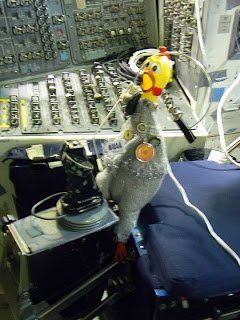One way for pilots to practice flying the Orbiter is in the simulator. But there is nothing like really flying. So NASA has the Shuttle Training Aircraft (STA). It is a training vehicle that duplicates the Space Shuttle's approach profile and handling qualities, allowing Space Shuttle pilots to simulate Shuttle landings under controlled conditions before attempting the task on board the actual orbiter. A sophisticated computer system installed on board the STA simulates the flight dynamics of the orbiter with nearly perfect accuracy. The STA's highly realistic simulation of the Orbiter is not limited to handling characteristics, but also implements the shuttle control interfaces for the pilot.
The orbiter is no glider at all. In fact, it is referred to as "The Flying Brick". See, the orbiter lacks the atmospheric engines that would allow it to just abandon a landing approach, go around, and try another approach. It truly is a "one-shot-deal".
After the orbiter re-enters our atmosphere it is a very heavy "glider" with not a lot of lift. So pilots use the STA to practice the orbiters behavior in flight.
Now if you are a pilot, you will appreciate how the STA is configured to closely match the orbiter's brick-flying descent rate and drag profile:
At 37,000 feet (11,300 m) the main landing gear is lowered (the nose gear stays retracted due to wind load constraints) and the STA engine thrust is reversed. Its flaps may deflect upwards to decrease lift as well as downwards to increase lift.
While flying the STA in simulation mode, the STA never touches down on the runway. If the pilot has done everything correct to the point where the pilot's eyes are 32 feet (or 10 meters) above the runway, a green light turns on, indicating the orbiter has landed. When that light comes on, that would be the exact position that the pilot's head would be during the actual landing of the orbiter. But the STA is still about 20 feet (or 6 meters) above ground.
I have not yet met a Shuttle pilot but that's on my list for the next two weeks. I'd love to hear more about their experiences with the STA and then actually flying the orbiter. I also heard that there is a competition to get the nose wheel right on the center line... bragging rights, I think!

The training aircraft that they offer here is so good. So much good training that you can get from it. The options are endless with what they get from it. It is a must to use for training. Personal Injury Lawyer Toronto
ReplyDeletecoach outlet
ReplyDeleteair jordan 8
toms wedges
coach outlet store online clearances
louis vuitton outlet online
coach outlet clearance
adidas running shoes
lebron 11
louis vuitton
michael kors outlet online
ray ban sunglasses
coach outlet store online clearances
coach outlet store online
coach outlet
coach outlet
true religion outlet
gucci handbags
louis vuitton purses
replica watches
polo ralph lauren outlet
ray ban sunglasses uk
timberland shoes
cheap air jordans
cheap air jordans
ghd flat iron
louis vuitton
nike air force 1
fitflops shoes
jordan retro 8
jordan 6s
chenyingying2016715